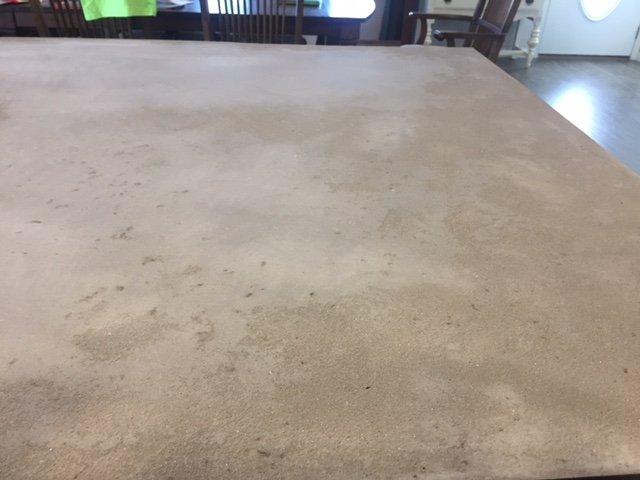DIY Concrete Countertops: How to Fix a Rough or Imperfect Surface
This image above shows a countertop that was steel troweled too early and left a soft dusty layer known as laitance.
Let’s face it, our first attempt at troweling may not always be the smoothest. Many things can contribute to a rough surface on your concrete countertop. Whether it be laitance, trowel marks, high spots, etc., there is no reason to panic. It can usually be fixed and you have options as to how you want to go about it.
The most common reason people get a rough surface is due to laitance. This happens when the concrete is troweled too early with the steel trowel. The trowel closes off the pores of the concrete so when this is done while there is still too much moisture in the concrete, the moisture gets trapped inside so it’s not able to evaporate properly. When the concrete cures, it usually looks very smooth and attractive however once you start sanding, that soft, dusty “cream layer” easily sands away and you’re left with a gritty, rough surface. If this cream layer isn’t removed and the concrete is sealed, you will notice that the sealer will chip or peel very easily. It can happen after a few weeks or even several months after being sealed however, it will eventually come up and need to be fixed. If you see this happening when you begin to sand, sand off the entire cream layer until you reveal the rough, gritty surface underneath. Then you can begin repairing.
Trowel marks are also a fairly common issue with pour in place countertops. The correct time to use the steel trowel is when the concrete is fairly set up. It shouldn’t be easy to slide the trowel around, some pressure is needed to smooth out the surface of the concrete. If the concrete is still too wet and the trowel slides and smooths the top easily without using pressure, it’s not yet time to trowel. It’s understandable that having to use pressure can result in some trowel marks, especially for beginners. To help avoid this we recommend a product called Trowel Slick. This is a liquid lubricant that is sprayed onto the concrete and/or the trowel itself in order to allow the trowel to glide smoothly over the surface and lessen the chance of imperfections.
Possibly the most difficult surface to fix is high/low spots. When you initially pour a concrete countertop, one of your first steps is to screed. This is done to push the concrete along your run and to ensure the concrete is level. Sometimes, when you vibrate the edges and the air starts escaping, the concrete can get lower in spots creating an uneven surface. It’s important to be mindful about this and fill in any low areas while the concrete is still very wet. If you happen to miss a spot, you will probably need to repair. Your options are more limited in this situation.
We’ve talked about the problems, now let’s talk about how to fix them. There are several ways to repair rough/uneven surfaces. The first and most common method is to grind and polish using a wet polisher and diamond polishing pads (and possibly a diamond cup wheel, depending on the severity of the imperfections). You would begin with the lowest grit necessary and work your way up. Usually you will go up to at least 200 grit. You can continue to polish higher but keep in mind that some stains and sealers won’t adhere to highly polished concrete. Wet polishing can be messy so some people opt for a dryer option, like our Diamond-Discs. They start with a fairly aggressive 60 grit and go up to 200 grit. These are not diamond in resin like the wet polishing pads, they are electroplated diamond discs. This means they don’t require such a high RPM and can be used on a regular palm sander. This won’t smooth the surface to the glass like finish that the wet polisher will but it will give the concrete a nice honed finish. Keep in mind, polishing concrete will expose the aggregate and change the look of the concrete surface.
Another option for smoothing a rough concrete surface is to apply a skim coat. You should never use regular concrete for this. Choose a product specifically made for skim coats, like our Micro-Topping. This is a cement based mix that is meant to be troweled on 1/16” to 1/8” thick. If you have low spots, this is probably going to be the best method. We recommend filling in the low spots first and then applying a final top coat over the entire surface.
Finally, you can apply epoxy over the concrete. This will fill in any rough areas making it smooth to the touch. You can add pigment or keep it clear. You can use a thinner, water based epoxy like our Aqua-Poxy or a more traditional solvent based epoxy like our Ultra Z Poxy. Whichever you choose, it can usually be matted by hand sanding if you aren’t interested in a gloss finish. The process for this will depend on the epoxy you choose. The options are almost unlimited as to what you can do with epoxy. Check out our website for more information.
The beauty of concrete is that the majority of issues can be fixed by using one or more of these methods. It’s very rare that a top will have to be ripped out completely and redone. If you’re not sure which method is best for your situation, reach out to us or other concrete professionals.
Writen By:

